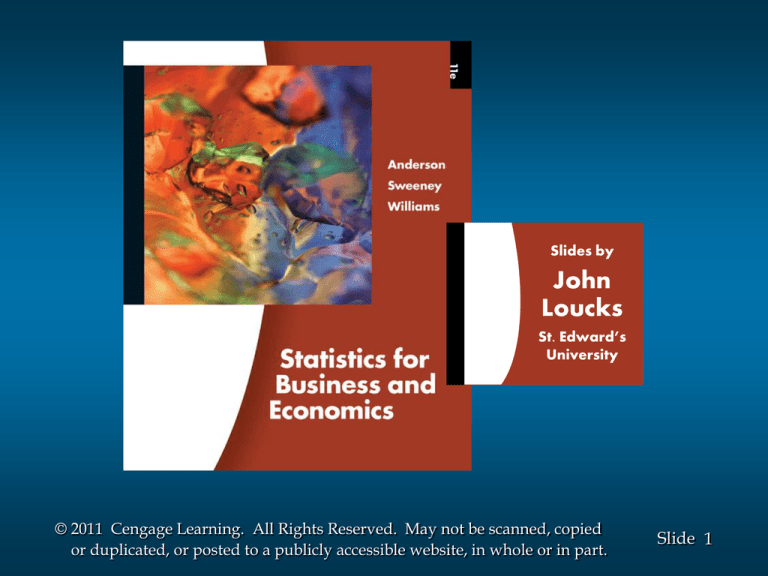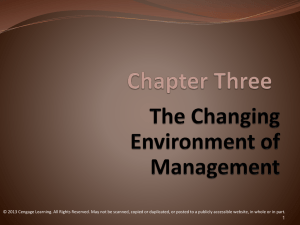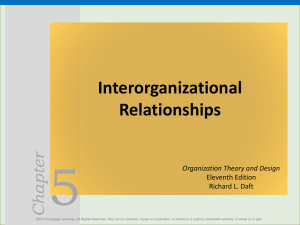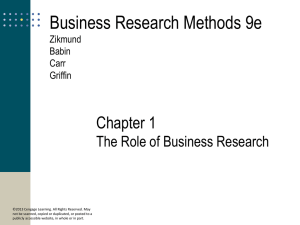
Slides by
John
Loucks
St. Edward’s
University
© 2011 Cengage Learning. All Rights Reserved. May not be scanned, copied
or duplicated, or posted to a publicly accessible website, in whole or in part.
Slide 1
Chapter 18, Part A
Forecasting
Quantitative Approaches to Forecasting
Time Series Patterns
Forecast Accuracy
Moving Averages and Exponential Smoothing
© 2011 Cengage Learning. All Rights Reserved. May not be scanned, copied
or duplicated, or posted to a publicly accessible website, in whole or in part.
Slide 2
Forecasting Methods
Forecasting methods can be classified as qualitative
or quantitative.
Qualitative methods generally involve the use of
expert judgment to develop forecasts.
Such methods are appropriate when historical data
on the variable being forecast are either not
applicable or unavailable.
We will focus exclusively on quantitative forecasting
methods in this chapter.
© 2011 Cengage Learning. All Rights Reserved. May not be scanned, copied
or duplicated, or posted to a publicly accessible website, in whole or in part.
Slide 3
Forecasting Methods
Quantitative forecasting methods can be used when:
past information about the variable being forecast
is available,
the information can be quantified, and
it is reasonable to assume that the pattern of the
past will continue into the future.
In such cases, a forecast can be developed using a
time series method or a causal method.
© 2011 Cengage Learning. All Rights Reserved. May not be scanned, copied
or duplicated, or posted to a publicly accessible website, in whole or in part.
Slide 4
Quantitative Forecasting Methods
Quantitative methods are based on an analysis of
historical data concerning one or more time series.
A time series is a set of observations measured at
successive points in time or over successive periods
of time.
If the historical data used are restricted to past
values of the series that we are trying to forecast, the
procedure is called a time series method.
If the historical data used involve other time series
that are believed to be related to the time series that
we are trying to forecast, the procedure is called a
causal method.
© 2011 Cengage Learning. All Rights Reserved. May not be scanned, copied
or duplicated, or posted to a publicly accessible website, in whole or in part.
Slide 5
Time Series Methods
The objective of time series analysis is to discover a
pattern in the historical data or time series and then
extrapolate the pattern into the future.
The forecast is based solely on past values of the
variable and/or past forecast errors.
© 2011 Cengage Learning. All Rights Reserved. May not be scanned, copied
or duplicated, or posted to a publicly accessible website, in whole or in part.
Slide 6
Causal Methods
Causal forecasting methods are based on the
assumption that the variable we are forecasting has
a cause-effect relationship with one or more other
variables.
Looking at regression analysis as a forecasting tool,
we can view the time series value that we want to
forecast as the dependent variable.
If we can identify a good set of related independent,
or explanatory, variables we may be able to develop
an estimated regression equation for forecasting the
time series.
© 2011 Cengage Learning. All Rights Reserved. May not be scanned, copied
or duplicated, or posted to a publicly accessible website, in whole or in part.
Slide 7
Regression Analysis
By treating time as the independent variable and the
time series as a dependent variable, regression
analysis can also be used as a time series method.
Time-series regression refers to the use of regression
analysis when the sole independent variable is time.
Cross-sectional regression refers to the use of
regression analysis when the independent variable(s)
is(are) something other than time.
© 2011 Cengage Learning. All Rights Reserved. May not be scanned, copied
or duplicated, or posted to a publicly accessible website, in whole or in part.
Slide 8
Forecasting Methods
Forecasting
Methods
Quantitative
Causal
Qualitative
Time Series
© 2011 Cengage Learning. All Rights Reserved. May not be scanned, copied
or duplicated, or posted to a publicly accessible website, in whole or in part.
Slide 9
Time Series Patterns
A time series is a sequence of measurements taken
every hour, day, week, month, quarter, year, or at
any other regular time interval.
The pattern of the data is an important factor in
understanding how the time series has behaved in
the past.
If such behavior can be expected to continue in the
future, we can use it to guide us in selecting an
appropriate forecasting method.
© 2011 Cengage Learning. All Rights Reserved. May not be scanned, copied
or duplicated, or posted to a publicly accessible website, in whole or in part.
Slide 10
Time Series Plot
A useful first step in selecting an appropriate
forecasting method is to construct a time series plot.
A time series plot is a graphical presentation of the
relationship between time and the time series
variable.
Time is on the horizontal axis, and the time series
values are shown on the vertical axis.
© 2011 Cengage Learning. All Rights Reserved. May not be scanned, copied
or duplicated, or posted to a publicly accessible website, in whole or in part.
Slide 11
Time Series Patterns
The common types of data patterns that can be
identified when examining a time series plot include:
Horizontal
Trend
Seasonal
Trend & Seasonal
Cyclical
© 2011 Cengage Learning. All Rights Reserved. May not be scanned, copied
or duplicated, or posted to a publicly accessible website, in whole or in part.
Slide 12
Time Series Patterns
Horizontal Pattern
• A horizontal pattern exists when the data
fluctuate around a constant mean.
• Changes in business conditions can often result in
a time series that has a horizontal pattern shifting
to a new level.
• A change in the level of the time series makes it
more difficult to choose an appropriate forecasting
method.
© 2011 Cengage Learning. All Rights Reserved. May not be scanned, copied
or duplicated, or posted to a publicly accessible website, in whole or in part.
Slide 13
Time Series Patterns
Trend Pattern
• A time series may show gradual shifts or
movements to relatively higher or lower values
over a longer period of time.
• Trend is usually the result of long-term factors
such as changes in the population, demographics,
technology, or consumer preferences.
• A systematic increase or decrease might be linear
or nonlinear.
• A trend pattern can be identified by analyzing
multiyear movements in historical data.
© 2011 Cengage Learning. All Rights Reserved. May not be scanned, copied
or duplicated, or posted to a publicly accessible website, in whole or in part.
Slide 14
Time Series Patterns
Seasonal Pattern
• Seasonal patterns are recognized by seeing the
same repeating pattern of highs and lows over
successive periods of time within a year.
• A seasonal pattern might occur within a day, week,
month, quarter, year, or some other interval no
greater than a year.
• A seasonal pattern does not necessarily refer to the
four seasons of the year (spring, summer, fall, and
winter).
© 2011 Cengage Learning. All Rights Reserved. May not be scanned, copied
or duplicated, or posted to a publicly accessible website, in whole or in part.
Slide 15
Time Series Patterns
Trend and Seasonal Pattern
• Some time series include a combination of a trend
and seasonal pattern.
• In such cases we need to use a forecasting method
that has the capability to deal with both trend and
seasonality.
• Time series decomposition can be used to separate
or decompose a time series into trend and
seasonal components.
© 2011 Cengage Learning. All Rights Reserved. May not be scanned, copied
or duplicated, or posted to a publicly accessible website, in whole or in part.
Slide 16
Time Series Patterns
Cyclical Pattern
• A cyclical pattern exists if the time series plot shows
an alternating sequence of points below and above
the trend line lasting more than one year.
• Often, the cyclical component of a time series is due
to multiyear business cycles.
• Business cycles are extremely difficult, if not
impossible, to forecast.
• In this chapter we do not deal with cyclical effects
that may be present in the time series.
© 2011 Cengage Learning. All Rights Reserved. May not be scanned, copied
or duplicated, or posted to a publicly accessible website, in whole or in part.
Slide 17
Selecting a Forecasting Method
The underlying pattern in the time series is an
important factor in selecting a forecasting method.
Thus, a time series plot should be one of the first
things developed when trying to determine what
forecasting method to use.
If we see a horizontal pattern, then we need to select
a method appropriate for this type of pattern.
If we observe a trend in the data, then we need to
use a method that has the capability to handle trend
effectively.
© 2011 Cengage Learning. All Rights Reserved. May not be scanned, copied
or duplicated, or posted to a publicly accessible website, in whole or in part.
Slide 18
Forecast Accuracy
Measures of forecast accuracy are used to determine
how well a particular forecasting method is able to
reproduce the time series data that are already
available.
Measures of forecast accuracy are important factors
in comparing different forecasting methods.
By selecting the method that has the best accuracy
for the data already known, we hope to increase the
likelihood that we will obtain better forecasts for
future time periods.
© 2011 Cengage Learning. All Rights Reserved. May not be scanned, copied
or duplicated, or posted to a publicly accessible website, in whole or in part.
Slide 19
Forecast Accuracy
The key concept associated with measuring forecast
accuracy is forecast error.
Forecast Error = Actual Value - Forecast
A positive forecast error indicates the forecasting
method underestimated the actual value.
A negative forecast error indicates the forecasting
method overestimated the actual value.
© 2011 Cengage Learning. All Rights Reserved. May not be scanned, copied
or duplicated, or posted to a publicly accessible website, in whole or in part.
Slide 20
Forecast Accuracy
Mean Error
A simple measure of forecast accuracy is the mean
or average of the forecast errors. Because positive and
negative forecast errors tend to offset one another, the
mean error is likely to be small. Thus, the mean error
is not a very useful measure.
Mean Absolute Error (MAE)
This measure avoids the problem of positive and
negative errors offsetting one another. It is the mean
of the absolute values of the forecast errors.
© 2011 Cengage Learning. All Rights Reserved. May not be scanned, copied
or duplicated, or posted to a publicly accessible website, in whole or in part.
Slide 21
Forecast Accuracy
Mean Squared Error (MSE)
This is another measure that avoids the problem of
positive and negative errors offsetting one another. It
is the average of the squared forecast errors.
Mean Absolute Percentage Error (MAPE)
The size of MAE and MSE depend upon the scale
of the data, so it is difficult to make comparisons for
different time intervals. To make such comparisons
we need to work with relative or percentage error
measures. The MAPE is the average of the absolute
percentage errors of the forecasts.
© 2011 Cengage Learning. All Rights Reserved. May not be scanned, copied
or duplicated, or posted to a publicly accessible website, in whole or in part.
Slide 22
Forecast Accuracy
To demonstrate the computation of these measures
of forecast accuracy we will introduce the simplest of
forecasting methods.
The naïve forecasting method uses the most recent
observation in the time series as the forecast for the
next time period.
Ft+1 = Actual Value in Period t
© 2011 Cengage Learning. All Rights Reserved. May not be scanned, copied
or duplicated, or posted to a publicly accessible website, in whole or in part.
Slide 23
Forecast Accuracy
Example: Rosco Drugs
Sales of Comfort brand headache medicine for the
past 10 weeks at Rosco Drugs are shown below.
If Rosco uses the naïve
Week Sales Week Sales
forecast method to
1
110
6
120
forecast sales for weeks
2
115
7
130
2 – 10, what are the
3
125
8
115
resulting MAE, MSE,
4
120
9
110
and MAPE values?
5
125
10
130
© 2011 Cengage Learning. All Rights Reserved. May not be scanned, copied
or duplicated, or posted to a publicly accessible website, in whole or in part.
Slide 24
Forecast Accuracy
Naïve Forecast Absolute Squared Abs.%
Week Sales Forecast
Error
Error
Error Error
1
2
3
4
5
6
7
8
9
10
110
115
125
120
125
120
130
115
110
130
110
115
125
120
125
120
130
115
110
5
10
-5
5
-5
10
-15
-5
20
Total
5
10
5
5
5
10
15
5
20
80
25
100
25
25
25
100
125
25
400
850
4.35
8.00
4.17
4.00
4.17
7.69
13.04
4.55
15.38
65.35
© 2011 Cengage Learning. All Rights Reserved. May not be scanned, copied
or duplicated, or posted to a publicly accessible website, in whole or in part.
Slide 25
Moving Averages
Naive Forecast Accuracy
MAE
80
8.89
9
850
MSE
94.44
9
65.35
MAPE
7.26%
9
© 2011 Cengage Learning. All Rights Reserved. May not be scanned, copied
or duplicated, or posted to a publicly accessible website, in whole or in part.
Slide 26
Moving Averages and Exponential Smoothing
Now we discuss three forecasting methods that
are appropriate for a time series with a horizontal
pattern:
Moving Averages
Weighted Moving Averages
Exponential Smoothing
They are called smoothing methods because their
objective is to smooth out the random fluctuations
in the time series.
They are most appropriate for short-range
forecasts.
© 2011 Cengage Learning. All Rights Reserved. May not be scanned, copied
or duplicated, or posted to a publicly accessible website, in whole or in part.
Slide 27
Moving Averages
The moving averages method uses the average of
the most recent k data values in the time series. As the
forecast for the next period.
Ft 1
(most recent k data values) Y Y
where:
t
k
t -1
Yt - k 1
k
Ft+1= forecast of the time series for period t + 1
Each observation in the moving average calculation
receives the same weight.
© 2011 Cengage Learning. All Rights Reserved. May not be scanned, copied
or duplicated, or posted to a publicly accessible website, in whole or in part.
Slide 28
Moving Averages
The term moving is used because every time a new
observation becomes available for the time series,
it replaces the oldest observation in the equation.
As a result, the average will change, or move, as
new observations become available.
© 2011 Cengage Learning. All Rights Reserved. May not be scanned, copied
or duplicated, or posted to a publicly accessible website, in whole or in part.
Slide 29
Moving Averages
To use moving averages to forecast, we must first
select the order k, or number of time series values,
to be included in the moving average.
A smaller value of k will track shifts in a time
series more quickly than a larger value of k.
If more past observations are considered relevant,
then a larger value of k is better.
© 2011 Cengage Learning. All Rights Reserved. May not be scanned, copied
or duplicated, or posted to a publicly accessible website, in whole or in part.
Slide 30
Moving Averages
Example: Rosco Drugs
If Rosco Drugs uses a 3-period moving average to
forecast sales, what are the forecasts for weeks 4-11?
Week
1
2
3
4
5
Sales
110
115
125
120
125
Week Sales
6
120
7
130
8
115
9
110
10
130
© 2011 Cengage Learning. All Rights Reserved. May not be scanned, copied
or duplicated, or posted to a publicly accessible website, in whole or in part.
Slide 31
Moving Averages
Week
Sales
1
2
3
4
5
6
7
8
9
10
11
110
115
125
120
125
120
130
115
110
130
3MA Forecast
(110 + 115 + 125)/3
116.7
120.0
123.3
121.7
125.0
121.7
118.3
118.3
© 2011 Cengage Learning. All Rights Reserved. May not be scanned, copied
or duplicated, or posted to a publicly accessible website, in whole or in part.
Slide 32
Moving Averages
3MA Forecast Absolute Squared Abs.%
Week Sales Forecast Error
Error
Error Error
1
2
3
4
5
6
7
8
9
10
110
115
125
120
125
120
130
115
110
130
116.7
120.0
123.3
121.7
125.0
121.7
118.3
Total
3.3
5.0
-3.3
8.3
-10.0
-11.7
11.7
6.6
3.3
5.0
3.3
8.3
10.0
11.7
11.7
53.3
10.89
25.00
10.89
68.89
100.00
136.89
136.89
489.45
© 2011 Cengage Learning. All Rights Reserved. May not be scanned, copied
or duplicated, or posted to a publicly accessible website, in whole or in part.
2.75
4.00
2.75
6.38
8.70
10.64
9.00
44.22
Slide 33
Moving Averages
3-MA Forecast Accuracy
MAE
53.3
7.61
7
489.45
MSE
69.92
7
44.22
MAPE
6.32%
7
The 3-week moving average approach provided
more accurate forecasts than the naïve approach.
© 2011 Cengage Learning. All Rights Reserved. May not be scanned, copied
or duplicated, or posted to a publicly accessible website, in whole or in part.
Slide 34
Weighted Moving Averages
Weighted Moving Averages
• To use this method we must first select the number
of data values to be included in the average.
• Next, we must choose the weight for each of the
data values.
• The more recent observations are typically
given more weight than older observations.
•
For convenience, the weights should sum to 1.
© 2011 Cengage Learning. All Rights Reserved. May not be scanned, copied
or duplicated, or posted to a publicly accessible website, in whole or in part.
Slide 35
Weighted Moving Averages
Weighted Moving Averages
• An example of a 3-period weighted moving
average (3WMA) is:
3WMA = .2(110) + .3(115) + .5(125) = 119
Weights (.2, .3,
and .5) sum to 1
Most recent of the
three observations
© 2011 Cengage Learning. All Rights Reserved. May not be scanned, copied
or duplicated, or posted to a publicly accessible website, in whole or in part.
Slide 36
Exponential Smoothing
• This method is a special case of a weighted moving
averages method; we select only the weight for the
most recent observation.
• The weights for the other data values are computed
automatically and become smaller as the
observations grow older.
• The exponential smoothing forecast is a weighted
average of all the observations in the time series.
• The term exponential smoothing comes from the
exponential nature of the weighting scheme for the
historical values.
© 2011 Cengage Learning. All Rights Reserved. May not be scanned, copied
or duplicated, or posted to a publicly accessible website, in whole or in part.
Slide 37
Exponential Smoothing
Exponential Smoothing Forecast
Ft+1 = aYt + (1 – a)Ft
where:
Ft+1 = forecast of the time series for period t + 1
Yt = actual value of the time series in period t
Ft = forecast of the time series for period t
a = smoothing constant (0 < a < 1)
and let:
F2 = Y1 (to initiate the computations)
© 2011 Cengage Learning. All Rights Reserved. May not be scanned, copied
or duplicated, or posted to a publicly accessible website, in whole or in part.
Slide 38
Exponential Smoothing
Exponential Smoothing Forecast
• With some algebraic manipulation, we can rewrite
Ft+1 = aYt + (1 – a)Ft as:
Ft+1 = Ft + a(Yt – Ft)
• We see that the new forecast Ft+1 is equal to the
previous forecast Ft plus an adjustment, which is a
times the most recent forecast error, Yt – Ft.
© 2011 Cengage Learning. All Rights Reserved. May not be scanned, copied
or duplicated, or posted to a publicly accessible website, in whole or in part.
Slide 39
Exponential Smoothing
Example: Rosco Drugs
If Rosco Drugs uses exponential smoothing
to forecast sales, which value for the smoothing
constant a, .1 or .8, gives better forecasts?
Week
1
2
3
4
5
Sales
110
115
125
120
125
Week Sales
6
120
7
130
8
115
9
110
10
130
© 2011 Cengage Learning. All Rights Reserved. May not be scanned, copied
or duplicated, or posted to a publicly accessible website, in whole or in part.
Slide 40
Exponential Smoothing
Using Smoothing Constant Value a = .1
F2 = Y1
= 110
F3 = .1Y2 + .9F2 = .1(115) + .9(110)
= 110.5
F4 = .1Y3 + .9F3 = .1(125) + .9(110.5) = 111.95
F5 = .1Y4 + .9F4 = .1(120) + .9(111.95) = 112.76
F6 = .1Y5 + .9F5 = .1(125) + .9(112.76) = 113.98
F7 = .1Y6 + .9F6 = .1(120) + .9(113.98) = 114.58
F8 = .1Y7 + .9F7 = .1(130) + .9(114.58) = 116.12
F9 = .1Y8 + .9F8 = .1(115) + .9(116.12) = 116.01
F10= .1Y9 + .9F9 = .1(110) + .9(116.01) = 115.41
© 2011 Cengage Learning. All Rights Reserved. May not be scanned, copied
or duplicated, or posted to a publicly accessible website, in whole or in part.
Slide 41
Exponential Smoothing
Using Smoothing Constant Value a = .8
F2 =
= 110
F3 = .8(115) + .2(110) = 114
F4 = .8(125) + .2(114) = 122.80
F5 = .8(120) + .2(122.80) = 120.56
F6 = .8(125) + .2(120.56) = 124.11
F7 = .8(120) + .2(124.11) = 120.82
F8 = .8(130) + .2(120.82) = 128.16
F9 = .8(115) + .2(128.16) = 117.63
F10= .8(110) + .2(117.63) = 111.53
© 2011 Cengage Learning. All Rights Reserved. May not be scanned, copied
or duplicated, or posted to a publicly accessible website, in whole or in part.
Slide 42
Exponential Smoothing (a = .1)
a = .1
Forecast Absolute Squared Abs.%
Week Sales Forecast
Error
Error
Error Error
1
2
3
4
5
6
7
8
9
10
110
115
125
120
125
120
130
115
110
130
110.00
110.50
111.95
112.76
113.98
114.58
116.12
116.01
115.41
5.00
14.50
8.05
12.24
6.02
15.42
-1.12
-6.01
14.59
Total
5.00
14.50
8.05
12.24
6.02
15.42
1.12
6.01
14.59
82.95
25.00
210.25
64.80
149.94
36.25
237.73
1.26
36.12
212.87
974.22
© 2011 Cengage Learning. All Rights Reserved. May not be scanned, copied
or duplicated, or posted to a publicly accessible website, in whole or in part.
4.35
11.60
6.71
9.79
5.02
11.86
0.97
5.46
11.22
66.98
Slide 43
Exponential Smoothing (a = .1)
Forecast Accuracy
82.95
MAE
9.22
9
974.22
MSE
108.25
9
MAPE
66.98
7.44%
9
Exponential smoothing (with a = .1) provided
less accurate forecasts than the 3-MA approach.
© 2011 Cengage Learning. All Rights Reserved. May not be scanned, copied
or duplicated, or posted to a publicly accessible website, in whole or in part.
Slide 44
Exponential Smoothing (a = .8)
a = .8
Forecast Absolute Squared Abs.%
Week Sales Forecast
Error
Error
Error Error
1
2
3
4
5
6
7
8
9
10
110
115
125
120
125
120
130
115
110
130
110.00
114.00
122.80
120.56
124.11
120.82
128.16
117.63
111.53
5.00
11.00
-2.20
4.44
-4.11
9.18
-13.16
-7.63
18.47
Total
5.00
11.00
2.20
4.44
4.11
9.18
13.16
7.63
18.47
75.19
25.00
121.00
7.84
19.71
16.91
84.23
173.30
58.26
341.27
847.52
© 2011 Cengage Learning. All Rights Reserved. May not be scanned, copied
or duplicated, or posted to a publicly accessible website, in whole or in part.
4.35
8.80
1.83
3.55
3.43
7.06
11.44
6.94
14.21
61.61
Slide 45
Exponential Smoothing (a = .8)
Forecast Accuracy
75.19
MAE
8.35
9
847.52
MSE
94.17
9
MAPE
61.61
6.85%
9
Exponential smoothing (with a = .8) provided
more accurate forecasts than ES with a = .1, but
less accurate than the moving average (with k = 3).
© 2011 Cengage Learning. All Rights Reserved. May not be scanned, copied
or duplicated, or posted to a publicly accessible website, in whole or in part.
Slide 46
End of Chapter 18, Part A
© 2011 Cengage Learning. All Rights Reserved. May not be scanned, copied
or duplicated, or posted to a publicly accessible website, in whole or in part.
Slide 47








